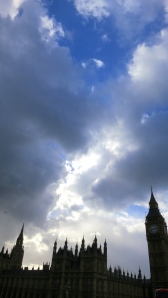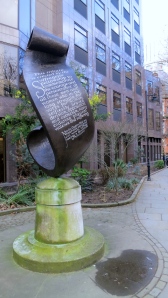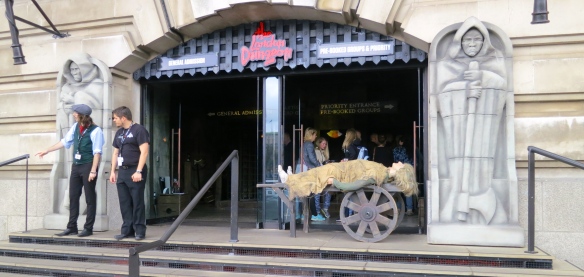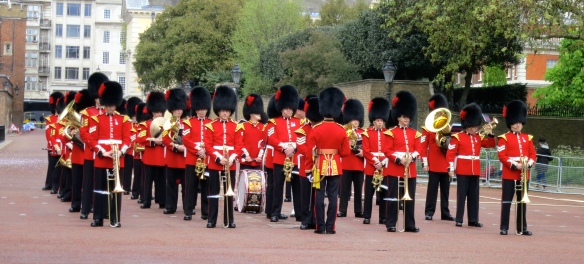Yesterday I promised Richard a copy of the photograph of him shovelling shingle. I printed it A3+ size today, and am very pleased with it.
Jackie drove me to Southampton Parkway after lunch. I then took my usual route to Carol’s, involving a train to Waterloo and a walk across Westminster Bridge and down Victoria Street.
On the south side of the River Thames The London Dungeon drew its usual crowds. At the top of the entrance steps stands a barrow loaded with human corpses wrapped in sacking.  The occasional hand escaping from its primitive body-bag no longer twitched, unlike those of a visitor anxious to venture inside to feast her eyes on further gruesome spectacles. Perhaps the dead bodies had once entered with rather more trepidation.
The occasional hand escaping from its primitive body-bag no longer twitched, unlike those of a visitor anxious to venture inside to feast her eyes on further gruesome spectacles. Perhaps the dead bodies had once entered with rather more trepidation.
 Rainclouds gathered above Westminster Bridge and the silhouettes of some of the most photographed buildings in the world.
Rainclouds gathered above Westminster Bridge and the silhouettes of some of the most photographed buildings in the world.

 Flocks of pigeons lazing and foraging in a now much reduced little green at the Victoria Street end of Broadway, suddenly disturbed, periodically took flight and arranged themselves on safe perches in the plane trees above.
Flocks of pigeons lazing and foraging in a now much reduced little green at the Victoria Street end of Broadway, suddenly disturbed, periodically took flight and arranged themselves on safe perches in the plane trees above.
The green is Christchurch Gardens which has a history probably unknown to the millions passing by. There is no surviving evidence of either of the two chapels or the Church of Christ Church Broadway which have stood on the site at different times.
A chapel dedicated to St Mary Magdalene had occupied the area then known as Tothill Fields as early as the 13th century. By 1598, according to John Stowe, the building was ‘now wholly ruined’.
 A new churchyard of St Margaret’s, known as The New Chapel was consecrated by the Dean of Westminster in December 1626. During the Commonwealth period it was used as a stable by Parliamentary soldiers and as avail for Scots prisoners captured at the Battle of Worcester. Twelve hundred of these prisoners were said to have died and been interred in the fields.
A new churchyard of St Margaret’s, known as The New Chapel was consecrated by the Dean of Westminster in December 1626. During the Commonwealth period it was used as a stable by Parliamentary soldiers and as avail for Scots prisoners captured at the Battle of Worcester. Twelve hundred of these prisoners were said to have died and been interred in the fields.
In the 19th century the New Chapel was demolished and replaced by Christ Church Broadway. Less than 100 years later, this in turn was destroyed by German incendiary bombs in the early morning of 17th April 1941.
Sadly, as in many London public spaces, this one now bears a sign telling you what you can’t do in them.
 On one corner is situated a tribute to those who suffered in the suffragette movement which fought for votes for women in the early twentieth century. The body of their leader, Emmeline Pankhurst, is buried in Brompton Cemetery. Her gravestone in the form of a celtic cross features in ‘The Magnificent Seven’.
On one corner is situated a tribute to those who suffered in the suffragette movement which fought for votes for women in the early twentieth century. The body of their leader, Emmeline Pankhurst, is buried in Brompton Cemetery. Her gravestone in the form of a celtic cross features in ‘The Magnificent Seven’.
After visiting Carol, I returned to Southampton where Jackie was waiting to drive me home.
 Noticing my reflection in the window of the 507 bus to Waterloo as it passed St. Thomas’s Hospital, I was reminded of the keen observation skills of Jackie and Judith Munns in August 2012. I had posted a photograph of the Sigoules boulangerie on an afternoon following a morning visit to the hairdressers there. ‘Good haircut’, Jackie had texted from England. How, I wondered, had she known? The answer was that I was unwittingly reflected in the baker’s window.
Noticing my reflection in the window of the 507 bus to Waterloo as it passed St. Thomas’s Hospital, I was reminded of the keen observation skills of Jackie and Judith Munns in August 2012. I had posted a photograph of the Sigoules boulangerie on an afternoon following a morning visit to the hairdressers there. ‘Good haircut’, Jackie had texted from England. How, I wondered, had she known? The answer was that I was unwittingly reflected in the baker’s window.
 On the return train journey, I amused my fellow travellers, most of whom were engrossed in laptops, by commenting that ‘when I commuted everyone read books’. ‘Times have changed’, was a young woman’s smiling reply.
On the return train journey, I amused my fellow travellers, most of whom were engrossed in laptops, by commenting that ‘when I commuted everyone read books’. ‘Times have changed’, was a young woman’s smiling reply.
When we arrived home we dined on superb sausage casserole (recipe); green beans; orange carrots; red cabbage with chillies; and yellow swede, potato, and onion mash.
Tag: The London Dungeon
A Splendid Occasion
Today completes a blogging year. As is appropriate for this particular one, it rained throughout in Minstead, although not in London.
Jackie was pleased to be able to drive Gladys and Dave to Southampton Parkway with us. Their trip to Edinburgh happily coincided with my London visits to Norman and Carol.
I took my usual walk from Waterloo to Green Park where I boarded my Jubilee Line train to Neasden.
I don’t normally plan a photograph or manipulate the image to change it. I picture what I see and crop if suitable. At almost any time of the day or night in central London, a helicopter will be seen hovering overhead or making a dash to a hospital.  Today one was hovering apparently motionless high above the Thames. After I’d photographed it, I realised the potential for setting the flying machine against the London Eye. Walking on to that feature of the skyline, I raised the camera and pressed the shutter.
Today one was hovering apparently motionless high above the Thames. After I’d photographed it, I realised the potential for setting the flying machine against the London Eye. Walking on to that feature of the skyline, I raised the camera and pressed the shutter.  Faster than the movement of my finger was the flight of the pigeon that stole the shot. Serendipity indeed.
Faster than the movement of my finger was the flight of the pigeon that stole the shot. Serendipity indeed.
The London Dungeon exhibition first opened in Tooley Street near Guy’s hospital some time in the 1970s. It is a series of waxworks tableaux representing historic horrific happenings in the capital. When Matthew and Becky were still quite young I took them there to see it. No way would they be persuaded to enter. These horrors are now housed in part of the old County Hall, alongside the river.  For years I have been under the misapprehension that it was such as the body that lies at the top of the steps outside the new premises that deterred our children. Not a bit of it. ‘It was the rats’, was the explanation Becky recently gave me. Given that Matthew soon kept them as pets, I was rather surprised by this.
For years I have been under the misapprehension that it was such as the body that lies at the top of the steps outside the new premises that deterred our children. Not a bit of it. ‘It was the rats’, was the explanation Becky recently gave me. Given that Matthew soon kept them as pets, I was rather surprised by this.
At eleven o’clock this morning Westminster Bridge was marginally easier than usual to traverse half way across. After this point it was far more populated than ever. Every race and nationality in the world must have been represented. Whitehall was cordoned off. The only way to cross it was via the public subway at Westminster tube station. The reason for the helicopter became apparent when police cars blocked the entrance to the Houses of Parliament car park. Every few feet along the approaching streets stood a police officer facing rows of crash barriers. Crowds of people packed the thoroughfare, cameras hopefully raised at arms lengths above the throngs. There seemed to me no chance of any point and shoot device snatching a reasonable image of the horse guards and ceremonial coaches glinting in the occasional sunshine.  I focussed on the crowds through which I was elbowing my way, thankful that I could see over most of the heads. I had stumbled upon the State Opening of Parliament.
I focussed on the crowds through which I was elbowing my way, thankful that I could see over most of the heads. I had stumbled upon the State Opening of Parliament.
Having reached the comparative sedateness of St. James’s Park, my way across The Mall was again blocked.  The band I had heard getting nearer as I crossed the park turned out to be a military one. The crash barriers and police protecting the musicians were supplemented the length of this famous street by guardsmen in their splendid uniforms. There was one pedestrian route across, reminiscent of Birdcage Walk during the London Marathon (see 25th September last year). Every so often one of the guards would present his rifle and march back and forth across the pathway, eventually returning to his place and shouldering arms.
The band I had heard getting nearer as I crossed the park turned out to be a military one. The crash barriers and police protecting the musicians were supplemented the length of this famous street by guardsmen in their splendid uniforms. There was one pedestrian route across, reminiscent of Birdcage Walk during the London Marathon (see 25th September last year). Every so often one of the guards would present his rifle and march back and forth across the pathway, eventually returning to his place and shouldering arms.  Pedestrians had to hang fire while this went on. The whole route from Admiralty Arch to Buckingham Palace was a sight to behold.
Pedestrians had to hang fire while this went on. The whole route from Admiralty Arch to Buckingham Palace was a sight to behold.
At the entrance to Green Park itself, a pair of golden arches suggested that McDonalds was now sponsoring this national treasure.
Walking through Brent’s Church Road market, I felt I was in a different city.
Norman produced a roast pork dinner followed by apple strudel, accompanied by a fine Italian red wine. I then took my usual route to Carol’s, and afterwards the amazingly frequent 507 bus to Waterloo and the train back to Southampton for Jackie to drive me home.
The two way train journey was sufficient for me to devour Jack London’s excellent story ‘The Call of the Wild’, in the Folio society edition, superbly illustrated by Abigail Rorer.  It is the savage yet tender tale of Buck, a phenomenal dog who eventually obeys the call.
It is the savage yet tender tale of Buck, a phenomenal dog who eventually obeys the call.

